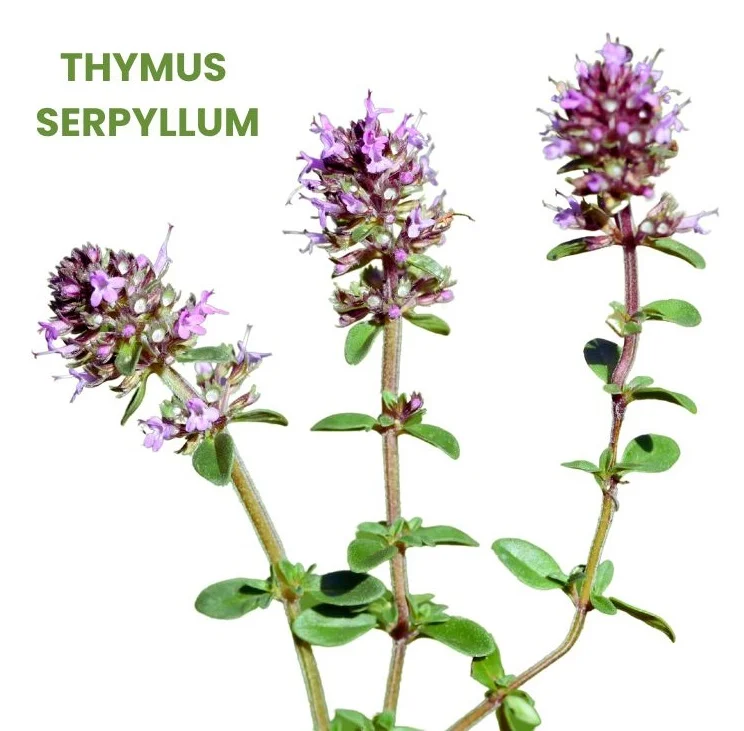Thymus serpyllum, commonly known as Wild Thyme, is a plant-based remedy used primarily in homeopathy.
It is particularly noted for its efficacy in treating respiratory conditions, especially in children.
It addresses dry, nervous asthma, whooping cough, and severe spasms with minimal sputum production.
Additionally, it is used to alleviate symptoms associated with throat irritation and ear pressure.

Table of Contents
ToggleSOURCE INFORMATION
Scientific Classification
- Kingdom: Plantae
- Order: Lamiales
- Family: Lamiaceae
- Genus: Thymus
- Species: Thymus serpyllum
Origin and Historical Facts
- Thymus serpyllum is a species of thyme native to Europe and parts of Asia.
- Historically, thyme has been used for various medicinal purposes, including respiratory issues and infections.
- The ancient Greeks and Romans utilized thyme for its antiseptic properties and to treat respiratory ailments.
- In homeopathy, Wild Thyme has been recognized for its ability to manage dry asthma and coughs, and to provide relief from throat and ear discomfort.
DRUG PATHOGENESIS
- Thymus serpyllum influences the respiratory and auditory systems.
- It is known for its role in treating dry, nervous asthma and whooping cough, especially where there is a lack of productive sputum.
- It also helps with throat discomfort characterized by burning sensations and worsened by empty swallowing.
- In addition, it addresses symptoms of ear pressure and ringing.
PHYSICAL CONSTITUTION, DIATHESIS, AND TEMPERAMENTS
- Physical Constitution: Beneficial for individuals with respiratory conditions and sensitivity to cold, particularly children who are prone to respiratory infections.
- Diathesis: Suitable for those with a tendency toward dry, spasmodic coughs and asthma.
- Temperament: Ideal for patients with a nervous disposition and a tendency toward respiratory spasms.
WHAT IS CONSTITUTION IN HOMOEOPATHY?
WHAT IS DIATHESIS IN HOMOEOPATHY?
WHAT ARE TEMPERAMENTS IN HOMOEOPATHY?
KEY CHARACTERISTICS
- Respiratory Symptoms: Effective for dry, nervous asthma and whooping cough. Relieves severe spasms with little sputum.
- Ear Symptoms: Ringing in the ears with a feeling of pressure in the head.
- Throat Symptoms: Burning sensation in the pharynx, worsened by empty swallowing, with distended blood vessels and a dark appearance.
DETAILED ORGAN SYMPTOMS
RESPIRATORY SYSTEM
- Dry Asthma: Persistent coughing with little to no mucus production. Typically, the cough is accompanied by nervousness and severe spasms.
- Whooping Cough: A severe cough characterized by a “whooping” sound, often with minimal sputum.
EAR
- Ringing: Persistent ringing in the ears accompanied by a sensation of pressure in the head.
THROAT
- Burning Sensation: A burning feeling in the throat, which worsens with empty swallowing.
- The throat may appear dark with distended blood vessels.
MODALITIES
Worse
- Empty swallowing.
- During severe spasms.
Better
- Warmth and soothing remedies.
WHAT ARE MODALITIES IN HOMOEOPATHY?
RELATIONSHIP WITH OTHER DRUGS
Compare with
- Spongia tosta: For dry coughs with a barking quality and respiratory distress.
- Drosera: For whooping cough with a spasmotic cough.
- Ipecacuanha: For coughs with a great deal of nausea and minimal expectoration.
DOSE
- Tincture: Typically used in homeopathic practice, administered according to the condition and severity of symptoms.
Frequently Asked Questions
What is Thymus serpyllum used for in homeopathy?
- Thymus serpyllum is used to treat dry, nervous asthma, whooping cough, and severe respiratory spasms with minimal sputum production.
- It also helps with throat irritation and ear pressure.
How does Thymus serpyllum help with respiratory conditions?
- It alleviates dry, spasmodic coughs and asthma, providing relief from symptoms when there is little sputum and severe spasms.
What are the main symptoms that indicate the use of Thymus serpyllum?
- Key symptoms include dry asthma, whooping cough, ringing in the ears, burning throat sensations worsened by empty swallowing, and a feeling of pressure in the head.
How should Thymus serpyllum be administered?
- It is typically administered in tincture form, with dosage adjusted based on the patient’s symptoms and response.
Can Thymus serpyllum be used for children?
- Yes, it is particularly useful for respiratory infections in children, including dry asthma and whooping cough.
Glossary of Difficult Words
- Spasmodic: Relating to or characterized by sudden, involuntary muscle contractions or convulsions.
- Sputum: Mucus or phlegm that is coughed up from the respiratory tract.
- Pharynx: The part of the throat behind the mouth and nasal cavity, leading to the oesophagus and larynx.
- Distended: Swollen due to internal pressure.
- Hemiopia: Partial loss of vision in one-half of the visual field.
